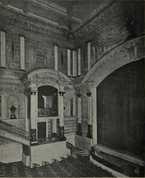Scala Theatre
Francis Thomas Verity
alias King's Concert Rooms (1780–1786), Regency Theatre (1815–1820), Cognoscenti Theatre (1802–1808), Scala Theatre (1905-1969), Fitzroy Theatre (1833–1835, 1837–1839), Prince of Wales's Royal Theatre (1865-1882), Hyde's Rooms (1786–1802), New Theatre (1808–1815), West London Theatre (1820–1831), Queen's Theatre (1831–1833, 1835–1837,1839-1865)Charlotte Street, | |
| show on the map | http://en.wikipedia.org/wiki/Scala_Theatre |
Important events
People
History
In 1903, Dr. Edmund Distin Maddick bought the property, and adjoining properties, and enlarged the site. The main entrance was now situate on Charlotte Street, and the old portico, on Tottenham Street became the stage door. The new theatre, designed by Frank Verity, opened in 1905, as The Scala Theatre, seating 1,139 and boasting a large stage. The new venture was not particularly successful, however, and became a cinema from 1911–1918, run by Charles Urban. In 1918, F. J. Nettlefold took over and ran the premises as a theatre again.
In: http://en.wikipedia.org/wiki/Scala_Theatre
Additional information
It became known as the New Scala in 1923, with D.A. Abrahams as licensee for both staging plays and showing films, becoming owner in 1925. Amateur productions and pantomime were performed, and for a while the theatre became home to the Gang Show. During World War II, it again housed professional theatre, reverting to the Scala Theatre. After the war, under the management of Prince Littler, amateur productions returned, with Peter Pan being the annual pantomime. This continued until 1969 when, after a fire, it was demolished for the building of offices, known as Scala House. In 1964, the theatre was used by The Beatles for the concert sequences in the film A Hard Day\\\'s Night. Today it is the site of an apartment block.
Joseph T. Rufer - 05.09. 2019
Add information







